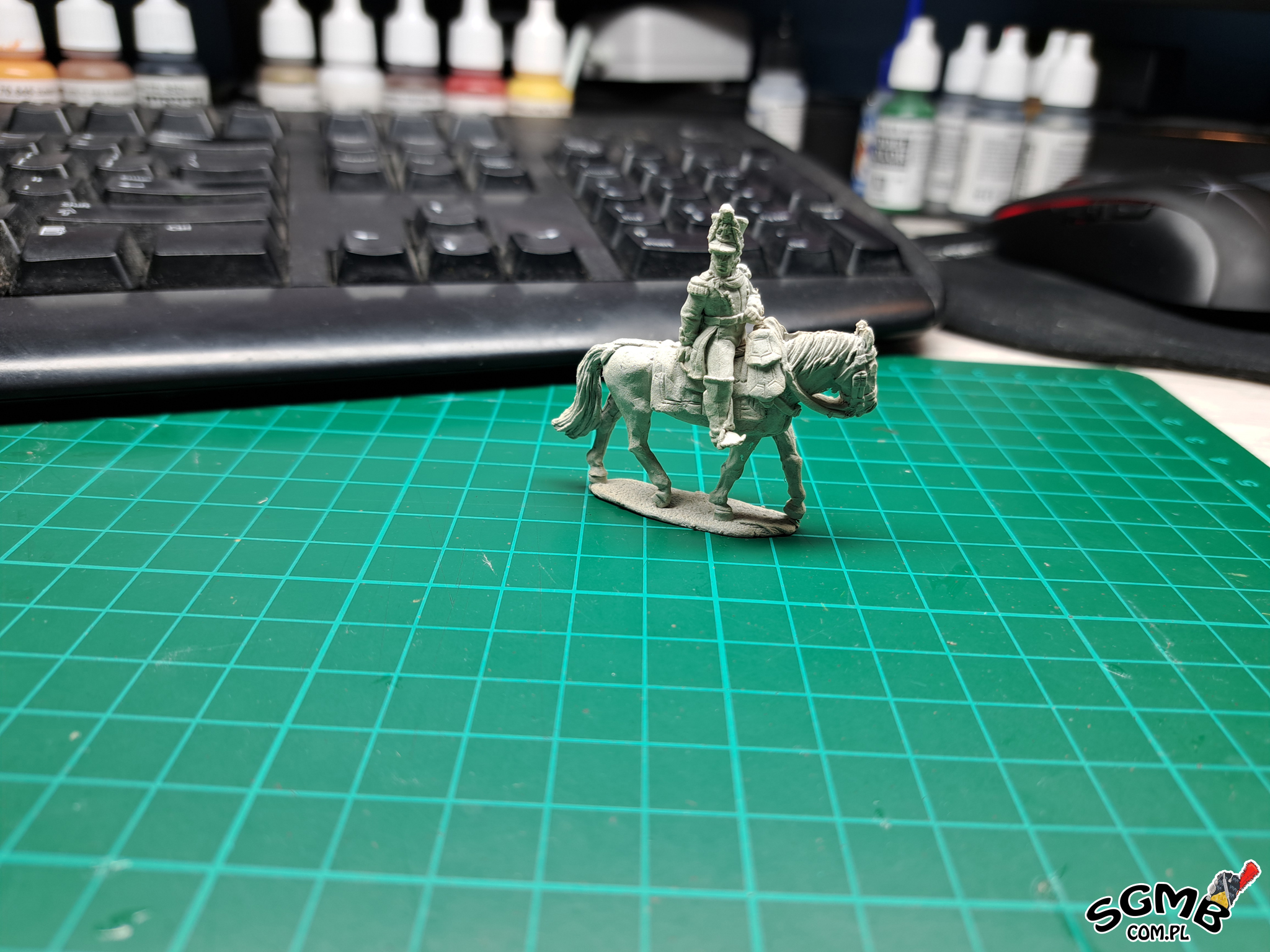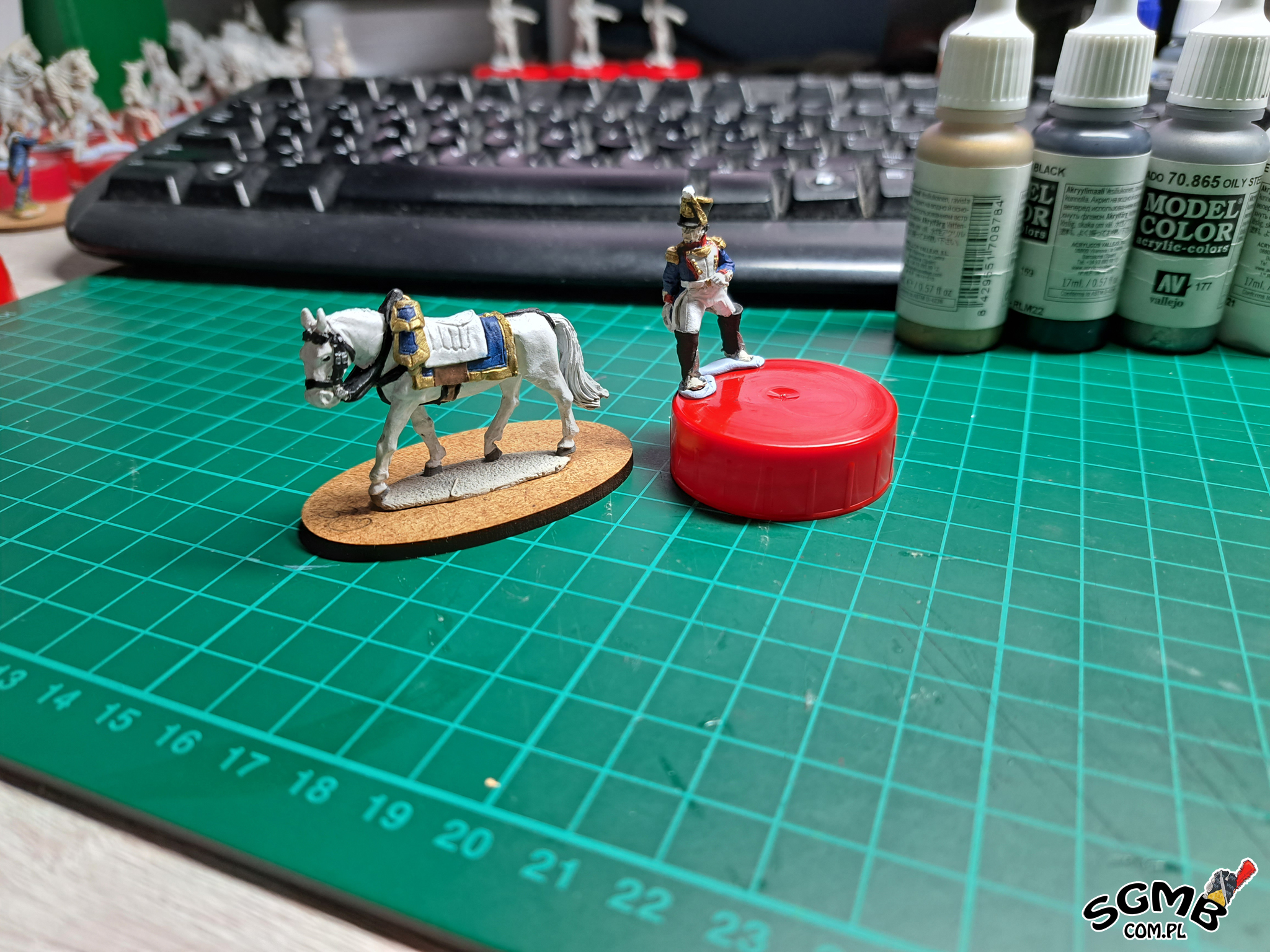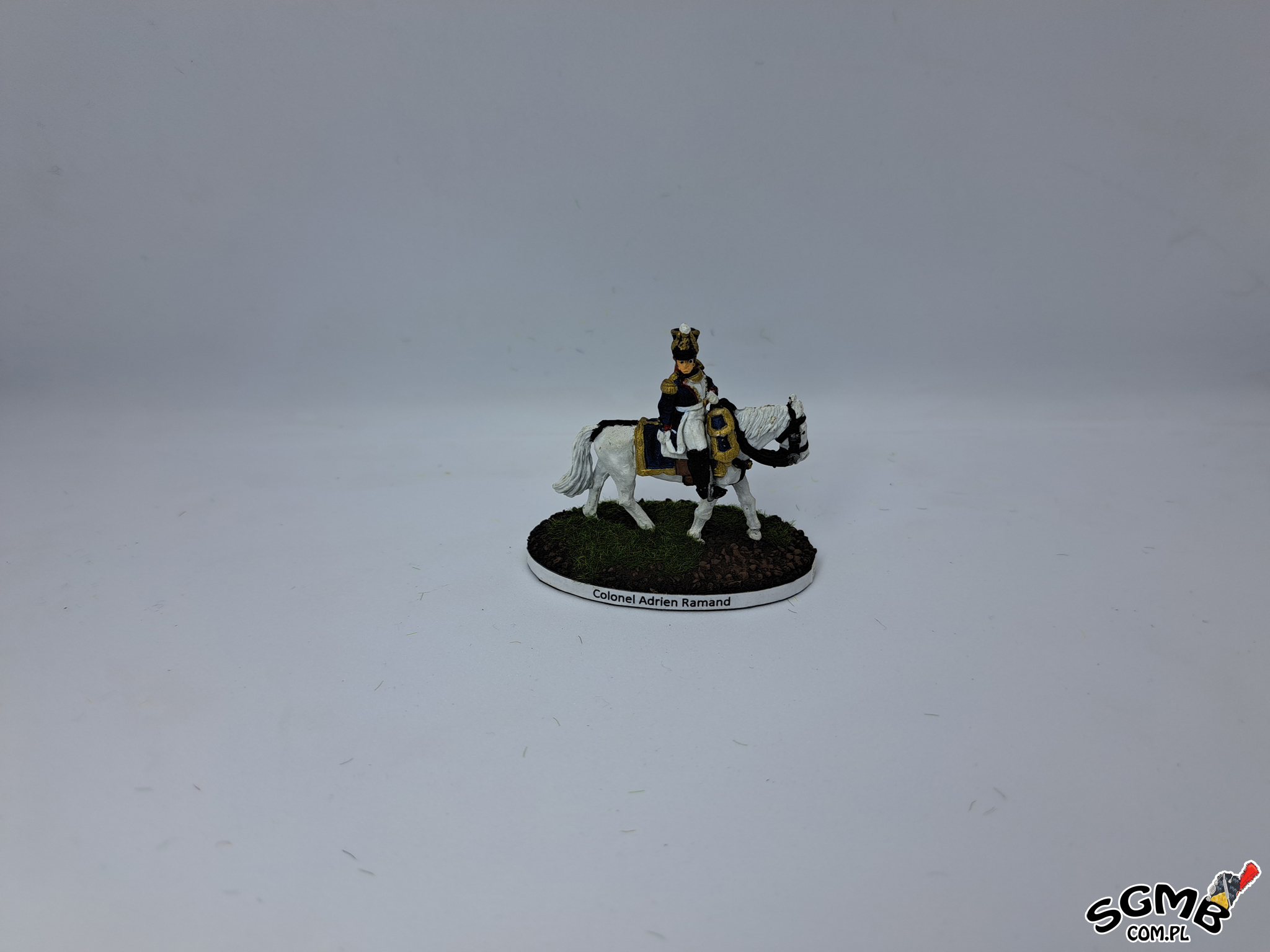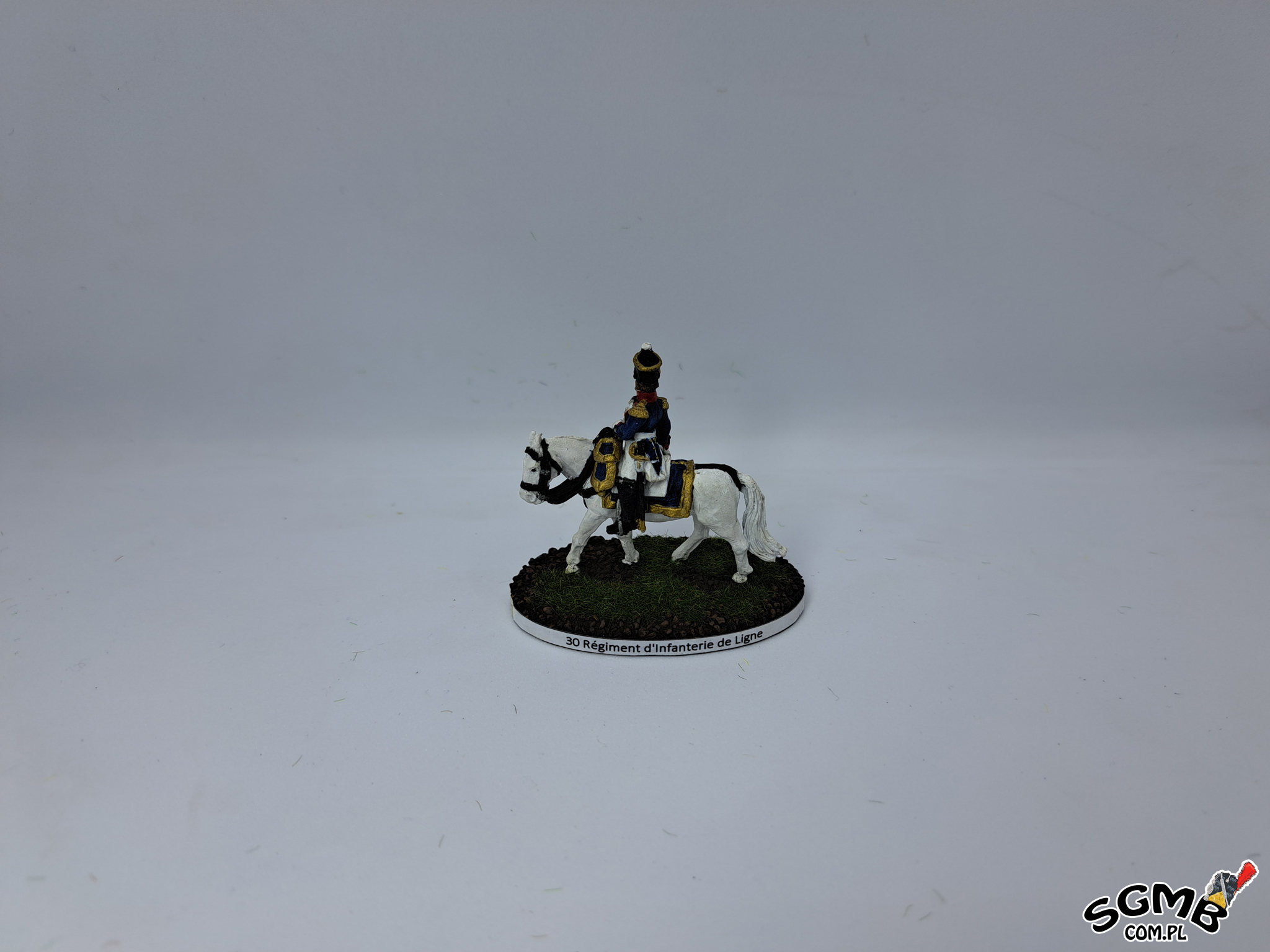[12.11.2023] Wojny Napoleońskie 28mm - Francja [1812]
|
30 Pułk Piechoty Liniowej - Pułkownik Adrien Ramand.
Dla 30 Pułku Piechoty Liniowej zrobiłem Pułkownika. |
30 Regiment Line Infantry - Colonel Adrien Ramand.
For the 30th Line Infantry Regiment I made a Colonel. |
30ème Régiment d'Infanterie de Ligne - Colonel Adrien Ramand [1812]
|
Adrien Ramand, urodził się 28 marca 1769 w Lyonie (Rodan), zmarł 6 stycznia 1843 w Collonges (Rodan).
Do armii wstąpił 5 stycznia 1786 r. jako żołnierz 59 Pułku Piechoty. 15 marca 1790 r. został kapralem, a 22 listopada 1791 r. sierżantem. 19 czerwca 1793 został podoficerem w 6 batalionie nadmorskim, a 11 listopada 1793 został mianowany podporucznikiem. Od 1792 roku służył kolejno w armiach Pirenejów, Północy , Renu i Włoch. W maju 1795 roku w bitwie pod Fort Saint-Elme wykazał się wielkim męstwem i został ranny w głowę. 17 listopada 1796 roku w bitwie pod d'Arcole jako pierwszy przepłynął pod najcięższym ogniem szeroki i głęboki kanał i swoim przykładem poprowadził swoich towarzyszy, którzy zbliżyli się do przeciwległego brzegu i przyczynili się do zwycięstwa. Został awansowany do stopnia porucznika 19 lutego 1797 r. 16 marca następnego roku podczas przeprawy przez Tagliamento został ranny w głowę odłamkiem. 6 października 1799 roku w bitwie pod Castricum ponownie się wyróżnił, otrzymał postrzał w nerki i w udo. 20 lutego 1801 roku wstąpił do Strzelców Gwardii Konsularnej, a stopień kapitana otrzymał 1 marca 1802 roku. 27 października 1802 roku otrzymał szablę honorową i został zatrudniony w obozie w Boulogne. 24 września 1803 otrzymał Legię Honorową, 14 czerwca 1804 roku został mianowany oficerem, a cesarz mianował go członkiem kolegium elektorów departamentu Rodanu. Od 1805 do 1807 brał udział w kampaniach na terenie Niemiec, Prus i Polski, następnie w 1808 wstąpił do armii hiszpańskiej. 5 kwietnia 1809 roku został mianowany dowódcą batalionu w 1 pułku Conscrits-Chasseurs i na tym stanowisku służył w kampaniach w niemczech i austrii. 15 marca 1810 roku został kawalerem Cesarstwa. Z Pułku Strzelców Gwardii Cesarskiej 17 marca 1811 roku awansował do stopnia pułkownika w 30 pułku piechoty liniowej, z którym brał udział w kampanii rosyjskiej w 1812 roku. W 1813 r. wraz z 30 Pułkiem Piechoty został wcielony do XIII Korpusu Wielkiej Armii, a 7 lutego 1813 r. został mianowany kawalerem Orderu Żelaznej Korony. W 1814 r. brał udział w blokadzie Hamburga, został ranny w udo na wyspie Wilhemsboug. Podczas pierwszej renowacji król Ludwik XVIII 13 sierpnia 1814 roku mianował go kawalerem Świętego Ludwika. W czasie Stu Dni odbył kampanię belgijską jako Pułkownik 30 Pułku Piechoty Liniowej w składzie 12 dywizji piechoty IV korpusu Armii Północy. Został zwolniony z wojska 21 września 1815 r. Zmarł 6 stycznia 1843 w Collonges-au-Mont-d'Or Źródło: https://fr.wikipedia.org/wiki/Adrien_Ramand |
Adrien Ramand, born on March 28, 1769 in Lyon (Rhône), died on January 6, 1843 in Collonges (Rhône).
He entered service on January 5, 1786 as a soldier of the 59th Infantry Regiment. On March 15, 1790, he became a corporal, and on November 22, 1791, a sergeant. On June 19, 1793, he became a non-commissioned officer in the 6th coastal battalion, and on November 11, 1793, he was appointed second lieutenant. From 1792, he served successively in the armies of the Pyrenees, the North, the Rhine and Italy. In May 1795, at the Battle of Fort Saint-Elme, he showed great bravery and was wounded in the head. On November 17, 1796, at the Battle of d'Arcole, he was the first to cross a wide and deep channel under the heaviest fire, and by his example he led his comrades, who approached the opposite shore and contributed to the victory. He was promoted to lieutenant on February 19, 1797. On March 16 of the following year, while crossing the Tagliamento, he was wounded in the head by shrapnel. On October 6, 1799, at the Battle of Castricum, he distinguished himself again and was shot in the kidneys and thigh. On February 20, 1801, he joined the Riflemen of the Consular Guard, and received the rank of captain on March 1, 1802. On October 27, 1802, he received the saber of honor and was employed in the camp in Boulogne. On September 24, 1803, he received the Legion of Honor, on June 14, 1804, he was appointed an officer, and the emperor appointed him a member of the electoral college of the Rhône department. From 1805 to 1807 he took part in campaigns in Germany, Prussia and Poland, then in 1808 he joined the Spanish army. On April 5, 1809, he was appointed battalion commander in the 1st Conscrits-Chasseurs regiment and in this position he served in campaigns in Germany and Austria. On March 15, 1810, he became a Knight of the Empire. From the Rifle Regiment of the Imperial Guard, on March 17, 1811, he was promoted to the rank of colonel in the 30th Line Infantry Regiment, with which he took part in the Russian campaign in 1812. In 1813, with 30 Line he was conscripted into the XIII Corps of the Grand Army, and on February 7, 1813, he was appointed a Knight of the Order of the Iron Crown. In 1814, he took part in the blockade of Hamburg and was wounded in the thigh on the island of Wilhemsboug. During the first renovation, King Louis XVIII appointed him Knight of Saint Louis on August 13, 1814. During the Hundred Days, he served in the Belgian campaign as Colonel of the 30th Line Infantry Regiment in the 12th Infantry Division of the 4th Corps of the Northern Army. He was discharged from the army on September 21, 1815. He died on January 6, 1843 in Collonges-au-Mont-d'Or Source: https://fr.wikipedia.org/wiki/Adrien_Ramand |
Materiały 30ème Régiment d'Infanterie de Ligne - Colonel Adrien Ramand [1812]
| Figurki | Zestaw |
| 1 figurka | FN4 Mounted Infantry Colonels. (Perry Miniatures) |
| Podstawki | Wymiary |
| MDF | 1x 60x35x3 owalna |
| Podstawki | Materiał |
| Kamyczki - Stones | BMPO50 Black Sand 1-1,5mm (Battle-Models) |
| Kamyczki - Stones | BMPO20 Black Sand 0,05-0,3mm (Battle-Models) |
| Trawa - Grass | 08150 Streugras "Frühlingswiese" (Noch) |
| Farba - baza - Paint - base | 70.941 Burnt Lumber (Vallejo) |
| Farba - rozjaśnienie - Paint - lightening | 70.825 Ger.C. pale. Brown (Vallejo) |
| Farba | Miejsce |
| 70.899 Dark Prussian Blue (Vallejo) | Mundur, Siodło - Uniform, Saddle |
| 70.950 Black (Vallejo) | Buty, Czako, Lejce - Shoes, Shako, Reins |
| 70.951 White (Vallejo) | Mundur, Umaszczenie Konia, Czako - pompon, - Uniform, Horse, Shako - pompon |
| 70.957 Flat Red (Vallejo) | Mundur - Uniform |
| 70.878 Old Gold (Vallejo) | Szabla, Czako, Epolety - Sabre, Shako, Epolets |
| 70.865 Oily Steel (Vallejo) | Szabla - Sabre |
| 70.825 Ger. C. Pale Brown (Vallejo) | Siodło - Saddle |
| 70.870 Medium Sea Grey (Vallejo) | Umaszczenie Konia - Kopyta - Horse - hoof |
| 70.845 Sunny Skin Tone (Vallejo) | Skóra - Skin |

































